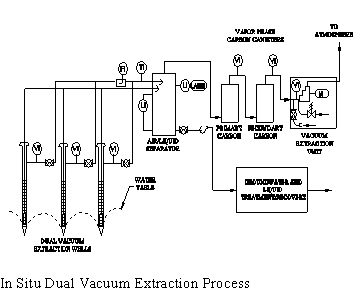
In situ or ex situ vacuum extraction is a process that removes volatile organic compounds (VOC) and many semivolatile organic compounds (SVOC) from the vadose, or unsaturated, soil zone. These compounds can often be removed from the vadose zone before they contaminate groundwater. Soil piles also may be cleaned by ex situ extraction vacuum. The in situ vacuum extraction process has been patented by others and licensed to Terra Vac and others in the United States.
The extraction process uses readily available equipment, including extraction and monitoring wells, manifold piping, air-liquid separators, and vacuum pumps. Vacuum extraction systems may vent directly to the atmosphere or through an emission control device. After the contaminated area is generally characterized, extraction wells are installed and connected by piping to the vacuum extraction and vapor treatment systems.
First, a vacuum pump creates a vacuum in the soil causing in situ volatilization and draws air through the subsurface. Contaminants are removed from the extraction wells and pass to the air-liquid separator. The vapor-phase contaminants may be treated with an activated carbon adsorption filter, a catalytic oxidizer, or another emission control system before the gases are discharged to the atmosphere. Subsurface vacuum and soil vapor concentrations are monitored with vadose zone monitoring wells.
The technology can be used in most hydrogeological settings and may reduce soil contaminant levels from saturated conditions to nondetectable. The process also works in fractured bedrock and less permeable soils (clays) with sufficient permeability. The process may be used to enhance bioremediation (bioventing). It also may be used in conjunction with dual vacuum extraction, soil heating, pneumatic fracturing, and chemical oxidation to recover a wide range of contaminants. The figure below illustrates one possible configuration of the process.

Typical contaminant recovery rates range from 20 to 2,500 pounds (10 to 1,000 kilograms) per day, depending on the degree of site contamination and the design of the vacuum extraction system.
The vacuum extraction technology may treat soils containing virtually any VOC. It has removed over 40 types of chemicals from soils and groundwater, including solvents and gasoline- and diesel-range hydrocarbons.
The process was accepted into the SITE Demonstration Program in 1987. The process was demonstrated under the SITE Demonstration Program at the Groveland Wells Superfund site in Groveland, Massachusetts, from December 1987 through April 1988. The technology remediated soils contaminated with trichloroethene (TCE). The Technology Evaluation Report (EPA/540/5-89/003a) and Applications Analysis Report (EPA/540/A5-89/003) are available from EPA.
The vacuum extraction process was first demonstrated at a Superfund site in Puerto Rico in 1984. Terra Vac has since applied the technology at more than 20 additional Superfund sites and at more than 700 other waste sites throughout the United States, Europe, and Japan.
During the Groveland Wells SITE demonstration, four extraction wells pumped
contaminants to the process system. During a 56-day period, 1,300 pounds
of VOCs, mainly TCE, were extracted from both highly permeable strata and
less permeable (10-7 centimeters per second) clays. The vacuum extraction
process achieved nondetectable VOC levels at some locations and reduced the
VOC concentration in soil gas by 95 percent. Average reductions of soil
concentrations during the demonstration program were 92 percent for sandy
soils and 90 percent for clays. Field evaluations yielded the following
conclusions:
TECHNOLOGY DEVELOPER CONTACTS:
Loren Martin
Terra Vac
Windsor Industrial Park, Building 15
92 N. Main Street
P.O. Box 468
Windsor, NJ 08561-0468
609-371-0070
Fax: 609-371-9446
James Malot
Terra Vac
356 Fortaleza Street
P.O. Box 1591
San Juan, PR 00902-1591
787-723-9171
Fax: 787-725-8750
E-Mail: jim@pr.terravac.com
Home page: www.terravac.com